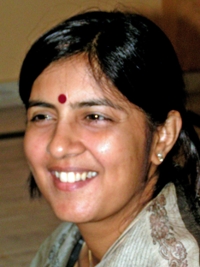One of my survey questions was designed to address the potential effectiveness of Tulsi's ninth vow to not participate in socially evil customs. To examine the present views of dowry among my respondents, I ran some cross-tabulations on the data from my questions on dowry including the variables of: gender, age, household income and Anuvrati versus non-Anuvrati status. The dowry question was: "Have you ever accepted or offered a dowry?" As displayed in Table 3, nine out of thirteen respondents in the youngest age group (18-22 years old) said "no." I found that many young respondents did not answer to the dowry question at all. One reason for the lack of response could be that the group of young respondents have not yet experienced the situation of accepting or rejecting a dowry. However, in keeping with the majority of respondents in this group who answered "no," it could also be a reflection of the changing attitudes in Indian society, which would indicate that the younger generation is rejecting cultural traditions and adopting more modern views of marriage as an institution. In total, 25 out of 174 responded, "yes" to having accepted or offered a dowry. An interesting finding is that 24% of those who reported "yes" were Anuvratis and 10% were non-Anuvratis. Such a finding is significant if only to observe that some of the Anuvratis, those who had taken a vow not to participate in dowry, still said they had participated. The data also may represent some ambiguity in terms of the definition of dowry in Indian society. Some Anuvratis explained to me in interviews that for their sons' marriages, they followed the vows and did not take any dowry from the bride's family, but for their daughters' marriages, they did give "gifts," but not as a dowry. Thereupon, such attitudes demonstrate just how strong the cultural pressures are to participate in dowry.
Table 3. "Have You Ever Accepted or Offered Dowry?"
Yes
No
Yes
Before Becoming AnuvratiNot Relevant
to my SituationMissing
Total
Anuvrati
19
17.2%72
65.4%7
6.3%11
10.0%1
0.9%110
100%Non-Anuvrati
6
9.3%45
70.3%1
1.5%12
18.7%0
0.0%64
100%Total
25
14.3%117
67.2%8
4.6%23
13.21
0.5%174
100%
The next variable I examined was household income. As presented in Table 4 below, I observed that the majority of the participants in dowry exchange were from either the lowest or highest income groups. The participants from the middle-income groups had almost no participation in dowry. From my experience I have found that those in the middle-income group tend to be comparatively well educated and experience less social pressure to participate in dowry. In contrast, in the lower groups dowry is viewed as an important source of income for the family and represents potential for upward economic mobility. In the upper income group, dowry is often viewed as an opportunity to compete for status through a display of wealth.
Table 4. Household Income and Participation in Dowry
Household
IncomeYes
No
Yes
Before
Becoming AnuvratiNot
Relevant to
My
SitutionMissing
Total
20,000 or
7
31
3
3
1
45
Less
30.4%
25.8%
37.5%
12%
100%
25.4%
20,001-
3
20
0
4
0
27
35,000
13.10%
16.7%
0%
16%
0%
15.3%
35,001-
0
18
1
3
0
22
50,000
0%
15%
12.5%
12%
0%
12.4%
50,001-
0
7
0
4
0
11
75,000
0%
5.8%
0%
16%
0%
6.2%
75,000+
6
26.1%21 17.5%
2 25%
4 16%
0
0%33 18.6%
Rather Not
7
23
2
7
0
39
Say
30.4%
19.2%
25%
28%
0%
22%
Total
23
120
8
25
1
177
100%
100%
100%
100%
100%
100%
 Shivani Bothra
Shivani Bothra
